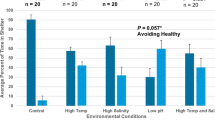Summary
The abilities of the cocoons of the spiders Mecynogea lemniscata and Argiope aurantia to protect the enclosed egg and spiderling stages from desiccation were investigated in the laboratory under controlled humidities, and in the field under ambient conditions. For M. lemniscata, which has a relatively small clutch (8–30 eggs) and remains in the cocoon for approximately 9–10 months, removal of the cocoon had no effect on water loss from the egg stage, nor did it adversely affect hatching or molting success. Cocoon removal did, however, significantly affect water loss and, consequently, survival in the spiderling stage at all humidities in the laboratory and in the field. The importance of the cocoon for survival is probably related to the unusually long time M. lemniscata spiderlings spend in the cocoon overwintering. For A. aurantia, which has a substantially larger clutch size (300–1400 eggs) and remains in the cocoon for a shorter 6–7 months, cocoon removal had no effect on water loss, egg hatching success, molting success, nor spiderling survival. The lack of an effect suggests that other factors (e.g., relative humidity at the oviposition site, or a large clutch size) may be more important in controlling water loss for A. aurantia.
Similar content being viewed by others
References
Abacus Concepts, SuperANOVA (1989) Abacus concepts, Inc., Berkeley
Anderson JF (1978) Energy content of spider eggs. Oecologia 37:41–57
Austin AD (1984) Life history of Clubiona robusta L. Koch and related species (Araneae: Clubionidae) in South Australia. J Arachnol 12:87–104
Austin AD (1985) The function of spider egg sacs in relation to parasitoids and predators with special reference to the Australia fauna. J Nat Hist 19:359–376
Austin AD, Anderson DT (1978) Reproduction and development of the spider Nephila edulis (Koch) (Araneae: Araneidae). Aust J Zool 26:501–518
Bristowe WS (1941) The comity of spiders. The Ray Society, London
Christenson TE, Wenzl PA (1980) Egg laying of the Golden Silk Spider, Nephila clavipes L. (Araneae: Araneidae): functional analysis of the egg sac. Anim Behav 28:1110–1118
Dawkins R, Krebs JR (1979) Arms races between and within species. Proc Royal Soc Lond Ser B 205:489–511
Foelix RF (1982) Biology of spiders. Harvard University Press, Cambridge
Gertsch WJ (1979) American spiders, 2nd edn. D. van Nostrand, New York
Grim JN, Slobodchikoff CN (1978) Chorion surface features of some spider eggs. Pan-Pacific Entomol 54:319–322
Grim JN, Slobodchikoff CN (1982) Spider egg chorion sphere size and density. Ann Entomol Soc Am 75:330–334
Hieber CS (1984a) Egg predators of the cocoons of the spider Mecynogea lemniscata (Araneae: Araneidae): rearing and population data. Florida Entomol 67:176–178
Hieber CS (1984b) The role of the cocoons of orb-weaving spiders. Ph.D. dissertation, University of Florida, Gainesville
Hieber CS (1985) The “insulation” layer in the cocoons of Argiope aurantia (Araneidae: Araneae). J Therm Biol 10:171–175
Hieber CS, Uetz GW (1990) Colony size and parasitoid load in two species of colonial Metepeira spiders from Mexico (Araneae: Araneidae). Oecologia 82:145–150
Horner NV, Starks KJ (1972) Bionomics of the jumping spider Mitaphidippus galathea. Ann Entomol Soc Am 65:602–607
Humphreys WF (1983) The surface of spider's eggs. J Zool 200:305–316
Kaston BJ (1981) Spiders of Connecticut. State Geo Nat Hist Survey, Bull No 70 Hartford
Levi HW (1968) The spider genera Gea and Argiope north of Mexico. Bull Mus Comp Zool 136:319–352
McCook HC (1890) American spiders and their spinning work, vol. II. Allen, Lane, and Scott., Philadelphia
McEwon KC (1963) Australian spiders. Sirius Books, Sydney
Norgaard E (1956) Environment and behavior of Theridion saxitile. Oikos 37:41–57
Opell BD (1984) A simple method for measuring desiccation resistance of spider egg sacs. J Arachnol 12:245–247
Peterson A (1964) Entomological techniques. Edwards Brothers, Inc., Ann Arbor
Robinson MH (1980) The ecology and behavior of tropical spiders. C.R. 8th Intern Congr Arachnol, Vienna: 13–32
Schaefer M (1976) An analysis of diapause and resistance in the egg stage of Floronia bucculenta (Araneae: Linyphiidae). Oecologia 25:155–174
Suter RB, Doyle G, Shane CM (1987) Oviposition site selection by Frontinella pyramitela (Araneae: Linyphiidae). J Arachnol 15:349–354
Turnbull AL (1973) The ecology of the true spiders (Araneomorphae). Annu Rev Entomol 18:305–348
Winer BJ (1962) Statistical principles in experimental design, 2nd edn. MaGraw-Hill, New York
Winston PW, Bates DH (1960) Saturated solutions for the control of humidity in biological research. Ecology 41:232–237
Zar JH (1984) Biostatistical Analysis, 2nd edn. Prentice Hall, Inc., Englewood Cliffs
Author information
Authors and Affiliations
Rights and permissions
About this article
Cite this article
Hieber, C.S. The role of spider cocoons in controlling desiccation. Oecologia 89, 442–448 (1992). https://doi.org/10.1007/BF00317424
Received:
Accepted:
Issue Date:
DOI: https://doi.org/10.1007/BF00317424




